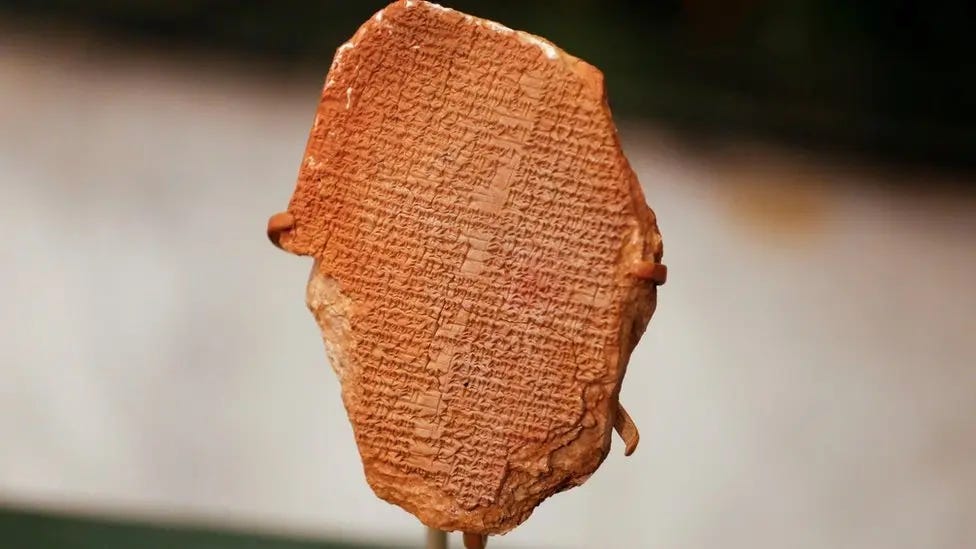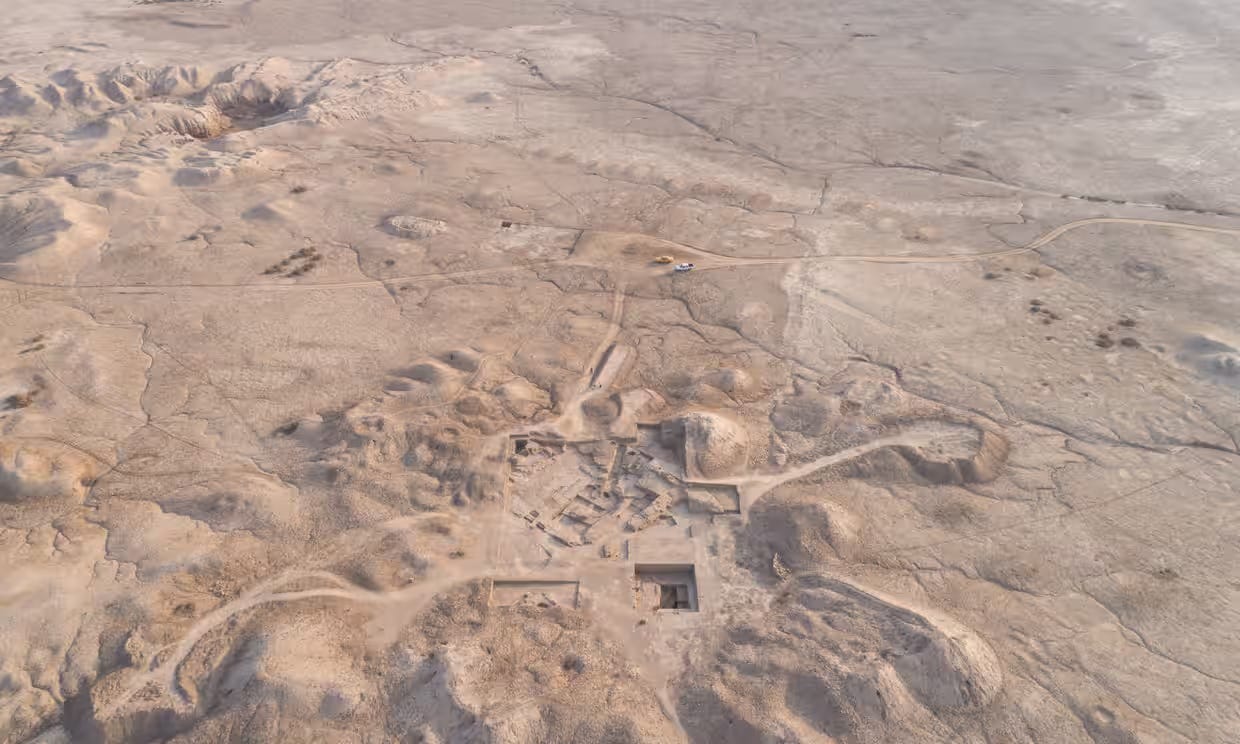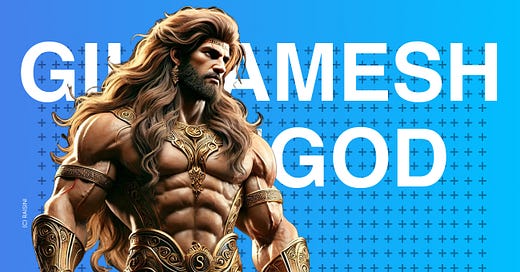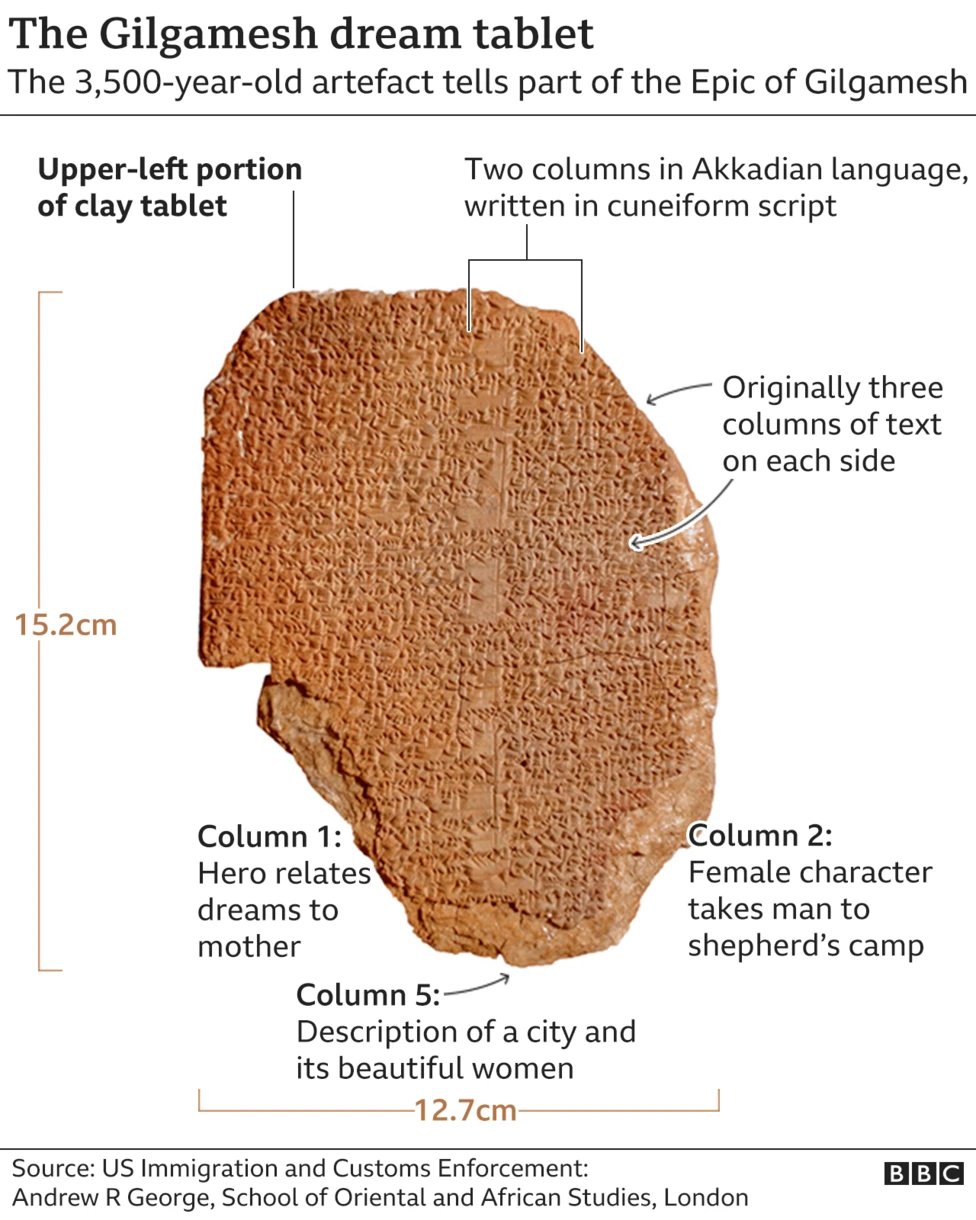The Legend of Demigod Gilgamesh: Did the US Military Invade Iraq to Uncover the Secrets of Gilgamesh’s Tomb?
Is Gilgamesh More Than a Legend? What Secrets Might the U.S. Be Hiding?
As a history and ancient civilization buff, I recently read the Epic of Gilgamesh and was fascinated by this legendary story and its profound themes.
As I started digging into the story of Gilgamesh, the Sumerian kings, and the origins of Mesopotamian civilization, I expected to find a wealth of information. To my surprise, though, I came up empty-handed. It’s strange that such a crucial part of history isn’t covered more extensively by leading news outlets. Aside from a couple of articles from Al Jazeera and the BBC, there wasn’t much to be found. It almost feels like there’s some sort of effort to keep this story under wraps. But the little I did uncover truly shocked me.
The historical richness, the recent archaeological discoveries, and the unsettling rumors surrounding the looting of Gilgamesh’s tomb all combine to make this tale more relevant than ever.
History is riddled with powerful stories of kings and leaders who have left an indelible mark on civilization. Yet, few tales are as captivating, mysterious, and, some might say, timely, as that of Gilgamesh—the legendary Sumerian king whose tomb was reportedly discovered in Iraq in the early 2000s.
Not only is Gilgamesh hailed as one of the most enduring characters in ancient literature, but recent rumors and conspiracy theories have suggested that his tomb was found and, controversially, seized by U.S. forces during their occupation of Iraq.
The whispers of this story bring into sharp focus the ever-present connection between ancient power and modern ambition. But what does this ancient epic—and the story of the "stolen" tomb—tell us about striving for greatness in our own lives?
The Epic of Gilgamesh: More Than Just a Myth
Download a copy of the Tablet in PDF here, courtesy of University of North Carolina.
For those unfamiliar with the story, the Epic of Gilgamesh is one of the world’s oldest surviving works of literature. Written over 4,000 years ago in Sumerian cuneiform on clay tablets, the epic follows the life of Gilgamesh, the mighty king of Uruk, one of the great city-states in ancient Mesopotamia, around 2800–2500 BCE, who is described as part human and part god. He is portrayed as a tyrant at first, using his power selfishly and oppressing his people.
The gods, in response, create Enkidu, a wild man sent to challenge Gilgamesh. After a fierce battle, the two become close friends and embark on heroic adventures together, slaying monsters and defying the gods. However, when Enkidu dies, Gilgamesh is devastated. His grief sends him on a desperate quest for immortality, leading him to the ends of the earth in search of the secret to eternal life.
Throughout his journey, Gilgamesh learns that immortality is not granted to mortals. Instead, he realizes that the legacy one leaves behind is the true form of immortality. This theme of legacy resonates deeply in both ancient and modern times, as it prompts us to consider what lasting impact we will leave on the world.
The Tomb of Gilgamesh: Discovery and Mystery
Fast forward to 2003, and an astonishing announcement emerges: archaeologists working in Iraq claim they may have found the tomb of Gilgamesh. Using ground-penetrating radar (GPR), German archaeologists led by Jorg Fassbinder discovered what they believed to be an ancient city buried beneath the desert sands near the Euphrates River. The findings seemed to perfectly match the descriptions of Uruk from the Epic of Gilgamesh, including sophisticated canals and a large burial chamber.
The significance of this discovery cannot be overstated. If this truly is the tomb of Gilgamesh, it would bridge the gap between mythology and history, giving scholars definitive evidence of a historical figure behind the ancient epic. The idea that Gilgamesh’s resting place had been found electrified the global archaeological community, as it could offer new insights into one of the earliest known civilizations and its legendary ruler.
However, before the archaeological team could complete their investigation, the U.S. invasion of Iraq began, forcing them to leave the site. Shortly after, rumors surfaced that U.S. forces had taken control of the site and removed artifacts. This has fueled conspiracy theories that the U.S. military seized the tomb for reasons beyond archaeology—possibly to recover ancient technology or knowledge believed to be hidden within.
Did the U.S. military invade Iraq specifically to uncover the secrets of Gilgamesh’s tomb? This question lingers, stirring intrigue and skepticism about the intersection of ancient treasures and modern military motives.
The U.S. Military’s Involvement: Conspiracy or Coincidence?
This discovery occurred at a critical moment in history: the U.S.-led invasion of Iraq in 2003. The world watched as Iraq was plunged into chaos, and amidst the destruction and uncertainty, the discovery of Gilgamesh’s tomb seemed to vanish from public consciousness. What makes this even more intriguing is that the site was allegedly secured by U.S. military personnel, raising eyebrows among conspiracy theorists.
According to some reports, shortly after the invasion, U.S. forces were seen conducting excavations at the site where the tomb was discovered. The archaeologists who had initially made the discovery were forced to abandon their work, and the media coverage of the find was abruptly cut off. Major news networks such as ABC News and BBC, which had previously reported on the discovery, went silent. Could it be that there was something in Gilgamesh’s tomb that the U.S. government wanted to keep hidden?
Theories abound, ranging from the plausible to the far-fetched. Some believe that the tomb contained advanced technology left behind by an ancient, possibly extraterrestrial civilization. Others suggest that it held esoteric knowledge related to immortality or otherworldly powers. These theories tap into a larger narrative about the ancient Sumerians, who are often credited with advanced knowledge of science, mathematics, and even space travel by fringe theorists. While mainstream historians dismiss these claims as speculative, the abrupt closure of the site and the removal of artifacts remain topics of debate.
One particularly popular theory posits that the U.S. military was interested in securing ancient knowledge related to the so-called "Stargates"—technologies believed to allow for instantaneous travel between different locations. These devices, mentioned in Sumerian mythology, have long been the subject of fascination for conspiracy theorists who believe that ancient civilizations possessed advanced technology far beyond what we understand today.
The Looting of Iraq’s National Museum and the Gilgamesh Tablet

While the tomb of Gilgamesh remains a subject of mystery, the looting of Iraq’s National Museum is a well-documented event. During the early days of the invasion, the museum—home to some of the most valuable artifacts from Mesopotamian civilization—was left unguarded. Thousands of priceless items were stolen, many of which have since disappeared into the black market. Among the most notable of these was the Gilgamesh Dream Tablet.
The Gilgamesh Dream Tablet, a 3,500-year-old artifact containing part of the Epic of Gilgamesh written in cuneiform, was one of the many treasures looted from Iraq’s museums during the Gulf War. In a twist of fate, the tablet found its way into the U.S. and was eventually purchased by Hobby Lobby, a chain of craft stores, in 2014 for $1.67 million to display at their Museum of the Bible in Washington, D.C.
However, in 2019, U.S. authorities seized the tablet after determining that it had been illegally smuggled into the country. According to a report from Al Jazeera, the U.S. Department of Justice concluded that the tablet had been looted from Iraq in the 1990s, around the time of the Gulf War. The U.S. government returned the Gilgamesh Tablet to Iraq in 2021, along with approximately 17,000 other artifacts that had been illegally taken from the country.
The story of the Gilgamesh Tablet highlights a broader issue surrounding the theft of cultural artifacts, particularly during times of war. Iraq, as the cradle of civilization, has been a frequent target for looters seeking to profit from its ancient treasures. But the return of these items to their rightful home in Iraq marks a step toward rectifying the historical wrongs committed during the invasion.
The Rediscovery of the Sumerian World: New Archaeological Findings
In recent years, archaeological work in Iraq has continued despite the challenges posed by war and instability. In 2023, a team led by Dr. Sebastien Rey made a groundbreaking discovery: a 4,500-year-old Sumerian palace in the ancient city of Girsu. This discovery, which included over 200 cuneiform tablets, offers new insights into the administrative and religious life of the Sumerians.
The palace, believed to be the seat of the kings of Girsu, is one of the most significant finds in recent Mesopotamian archaeology. It has shed light on the early urban development of the Sumerians, who are credited with many of the world’s firsts—writing, legal codes, and city-building. Girsu, located in modern-day southern Iraq, was a center of political and religious power during the third millennium BCE. Its rediscovery is a reminder of the importance of protecting and preserving Iraq’s cultural heritage.

The Girsu Project, a collaboration between the British Museum and Iraqi archaeologists, was funded by the Getty Museum in response to the destruction of cultural heritage sites by ISIS in recent years. The project has not only unearthed new historical information but has also trained a new generation of Iraqi archaeologists to carry on the work of preserving their country’s past.
The Broader Impact: The Loss and Recovery of Mesopotamian Heritage
The looting of Iraq’s cultural heritage during the Gulf War and the U.S. invasion was not limited to museums and well-known archaeological sites. Many smaller sites across the country were plundered, and thousands of artifacts have never been recovered. These objects, which tell the story of the world’s earliest civilizations, have been lost to private collectors, black markets, and illicit auctions. The loss of these items is a tragedy not only for Iraq but for the world, as they represent the shared heritage of humanity.
However, efforts to recover Iraq’s stolen artifacts have been gaining momentum. In addition to the return of the Gilgamesh Tablet, several international organizations have been working with the Iraqi government to locate and return other looted items. UNESCO has played a central role in these efforts, helping to identify stolen artifacts and ensure their safe return to Iraq.
The return of 17,000 artifacts, as reported by the BBC and Smithsonian Magazine, marks a significant milestone in the ongoing battle to restore Iraq’s cultural heritage. Many of these items date back to the Sumerian period, when writing, the wheel, and mathematics were first invented. The significance of these objects lies not only in their historical value but in their contribution to the understanding of human development. Their return offers hope that Iraq’s rich cultural heritage will one day be fully restored.
Conspiracy, Myth, and Reality: A Legacy of Ancient Wisdom
The mysteries surrounding the tomb of Gilgamesh, the looting of Iraq’s museums, and the return of the Gilgamesh Tablet are not just stories of the past; they reflect the ongoing tension between the preservation of cultural heritage and the forces that threaten it. Whether or not you subscribe to the conspiracy theories about U.S. involvement in the excavation of Gilgamesh’s tomb, it’s clear that ancient Mesopotamia continues to captivate the modern imagination.
The Sumerians, despite being one of the earliest known civilizations, laid the groundwork for much of the technology and knowledge that we take for granted today. From the development of written language to the codification of laws, their contributions have shaped the course of human history. And while we may never know the full extent of their knowledge, the rediscovery of their artifacts offers a glimpse into the minds of a people who were as curious and ambitious as we are today.
Gilgamesh and the Quest for Immortality: An Entrepreneur’s Lesson
Conspiracy theories aside, the legend of Gilgamesh offers more than just a fascinating look into ancient history. It also provides a valuable metaphor for anyone pursuing greatness in life or business. Much like Gilgamesh, the modern entrepreneur faces a world filled with challenges—obstacles that test both their resilience and ambition.
The ancient king’s journey was not just about ruling a kingdom but about leaving a legacy that would withstand the sands of time. His quest for immortality was not just about living forever, but about achieving something so great that it would never be forgotten.
For today’s business leaders and entrepreneurs, the pursuit of success is much the same. It’s not just about accumulating wealth or power; it’s about creating something enduring. Whether it's building a company, influencing industry trends, or leaving a mark on society, the drive to "live forever" through one’s work and achievements is a common theme.
Here are three key lessons we can draw from the story of Gilgamesh:
Ambition and Vision Matter: Just as Gilgamesh sought to rule with greatness, entrepreneurs must have a clear vision for their business or personal brand. Those who are successful don’t just think small—they think about how their actions will shape the future. What kind of legacy do you want to leave behind?
Resilience in the Face of Adversity: Gilgamesh’s journey was filled with challenges—from fighting mythical creatures to losing his closest friend, Enkidu. Similarly, entrepreneurs will face setbacks. Whether it’s financial struggles, market downturns, or personal failures, resilience is key to long-term success. How will you push through the inevitable obstacles on your path?
The Pursuit of Legacy, Not Just Success: Gilgamesh ultimately realized that immortality doesn’t come from living forever but from leaving behind a legacy. In business, this might mean building a brand that outlasts its founder or creating systems that continue to generate value long after you’re gone. What are you building today that will continue to have an impact tomorrow?
What Lies Beneath: Unanswered Questions and Final Thoughts
As for the tomb of Gilgamesh, it remains a mystery—one that straddles the line between historical fact and speculative fiction. Was it really found by archaeologists in Iraq? Did the U.S. military seize it, and if so, for what purpose? The lack of definitive answers only adds to the intrigue, making it a story that is likely to endure for generations to come. Whether you believe in the conspiracy or not, the mystery itself serves as a reminder of how much of our world—both past and present—remains undiscovered.
But perhaps the true value of this story lies in the timelessness of Gilgamesh’s legacy. In both the epic poem and the mystery of his tomb, we see a tale of ambition, loss, and the quest for something greater than oneself. As you build your own journey, whether in business, personal development, or life, the story of Gilgamesh serves as a reminder that greatness often comes from the pursuit of the impossible.
Much like the ancient king, today’s entrepreneurs and visionaries strive to create something that transcends their own existence—a business that thrives long after they’re gone, a brand that outlives its creator, or an impact that reverberates through time. And perhaps, in that sense, we all share a little bit of Gilgamesh’s ambition, forever chasing our own kind of immortality.
Share this story to a friend
If you enjoyed this story, share it with a friend and share your thoughts and questions in the Chat and ill be happy to answer.
See you next week,
RAISINI
👉🏻 Connect on LinkedIn - LEONIDAS RAISINI
👉🏻 Listen to my music - RAISINI
👉🏻 Work with me - www.LeonidasRaisini.com
Founding Member
You can also become a founding member, where you will get a 15 Minutes consultation call with me, have access to super exclusive stories including access to my new Music before others, meet in person (if we are in the same city), invite to our events. All for $150 per year. [This is also a great option if you happen to have, say, an employer-sponsored reading or education budget.]
Copyright RAISINI 2024. Any illegal reproduction of this content will result in immediate legal action.






